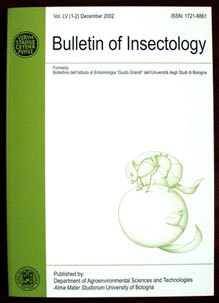Ver ítem
- xmlui.general.dspace_homeCentros e Institutos de InvestigaciónCICVyA. Centro de Investigación en Ciencias Veterinarias y AgronómicasInstituto de Microbiología y Zoología AgrícolaArtículos científicosxmlui.ArtifactBrowser.ItemViewer.trail
- Inicio
- Centros e Institutos de Investigación
- CICVyA. Centro de Investigación en Ciencias Veterinarias y Agronómicas
- Instituto de Microbiología y Zoología Agrícola
- Artículos científicos
- Ver ítem
Intraguild predation by Tupiocoris cucurbitaceus on Encarsia formosa and its influence on biological control of Trialeurodes vaporariorum
Resumen
The predator Tupiocoris cucurbitaceus (Spinola) and the parasitoid Encarsia formosa Gahan are natural enemies of Trialeurodes vaporariorum (Westwood) that can be found simultaneously in greenhouse tomato crops. Whether or not these species are involved in a trophic interaction with each other, and how this interaction might impact the control of the whitefly population has not been explored so far. In the present study, we evaluate the consumption and
[ver mas...]
The predator Tupiocoris cucurbitaceus (Spinola) and the parasitoid Encarsia formosa Gahan are natural enemies of Trialeurodes vaporariorum (Westwood) that can be found simultaneously in greenhouse tomato crops. Whether or not these species are involved in a trophic interaction with each other, and how this interaction might impact the control of the whitefly population has not been explored so far. In the present study, we evaluate the consumption and preference of T. cucurbitaceus for parasitized and nonparasitized T. vaporariorum nymphs. Furthermore, the effect that the joint presence of both natural enemies can have on the control of the whitefly population. Our results show that under laboratory conditions T. cucurbitaceus females engage in intraguild predation on E. formosa pupae. However, given the choice, the predator prefers to prey on healthy T. vaporariorum nymphs. Under greenhouse conditions, however, both T. cucurbitaceus and E. formosa reduce whitefly population when released separately, and their control is enhanced when released together.
[Cerrar]

Fuente
Bulletin of Insectology 76 (1) : 141-146 (enero 2023)
Fecha
2023-01-23
Editorial
Department of Agroenvironmental Sciences and Technologies, Università di Bologna
ISSN
1721-8861
2283-0332
2283-0332
Documentos Relacionados
Formato
pdf
Tipo de documento
artículo
Proyectos
(ver más)
INTA/2019-PE-E4-I074-001, Manejo Integrado de Plagas
Palabras Claves
Derechos de acceso
Abierto
 Excepto donde se diga explicitamente, este item se publica bajo la siguiente descripción: Creative Commons Attribution-NonCommercial-ShareAlike 2.5 Unported (CC BY-NC-SA 2.5)
Excepto donde se diga explicitamente, este item se publica bajo la siguiente descripción: Creative Commons Attribution-NonCommercial-ShareAlike 2.5 Unported (CC BY-NC-SA 2.5)


